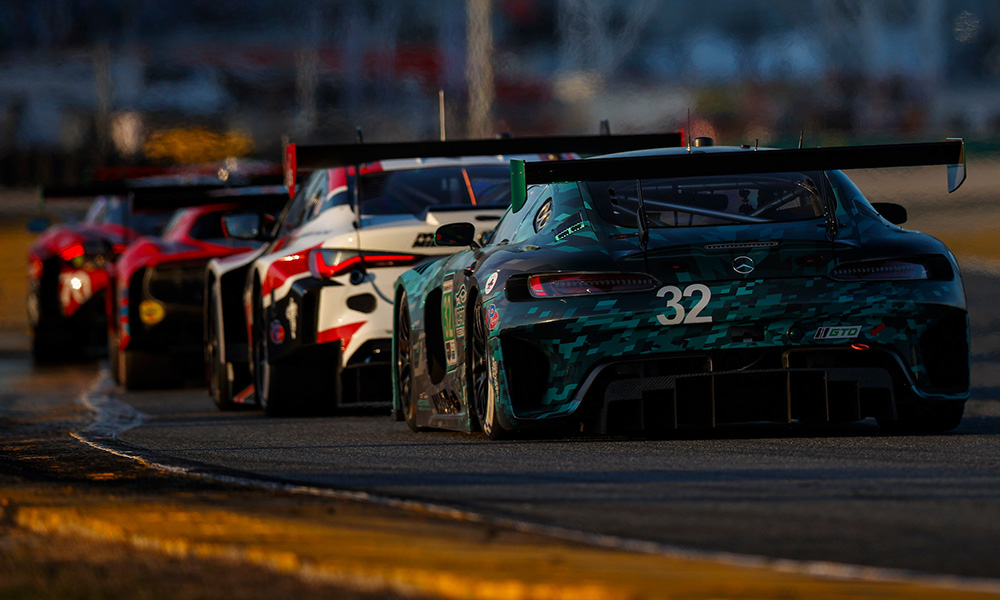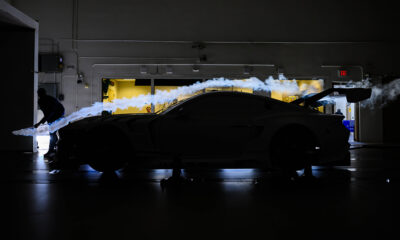
Photo: Jake Galstad/IMSA
IMSA has revised the Balance of Performance process for the GTD Pro and GTD classes beginning with next weekend’s Mobil 1 Twelve Hours of Sebring presented by Cadillac, largely reverting to a system based from last year but with increased manufacturer transparency.
Confirmed in a media roundtable on Friday morning, the sanctioning body, in support of the manufacturers, has re-taken control of the BoP process, following a system that was put into place ahead of the 2024 season that had manufacturers nominate its own performance expectations.
That system, which took into account data from December’s IMSA-sanctioned test at Daytona International Speedway, led to post-race penalties for both Ferrari and BMW for having “exceeded IMSA’s expectations as shared in the GT manufacturers technical working groups.”
Instead, IMSA’s technical committee will now declare BoP figures for the GT3 platform themselves, with full transparency between the manufacturers, as had previously been the case.
It was cited that the lack of a sanctioned BoP test at Sebring International Raceway prior to the event, along with manufacturer feedback, led to the reversal of its previous system.
IMSA’s senior technical director Matt Kurdock explained: “We concluded a technical working group yesterday with the OEMs discussing the process, discussing the performance targets for Sebring and the OEMs felt that carrying on in a manner where working towards a common performance targets would prove to be difficult, particularly as there was opportunity to conduct a Sebring sanctioned test.
“IMSA has taken some of the 2023 data in combination with some of the Rolex 24 data and has since devised a BoP solution for Sebring that’s basically a combination of those sources of data available with trying to hit a common performance target for the GTD and GTD Pro classes for the Sebring event.”
Kurdock added: “The manufacturers felt it was too difficult to work towards a common target. Having to perform the work in setting the parameters that hits a series of common targets.
“They’ve asked IMSA to retain the control going into Sebring, particularly as there’s no opportunity for a sanctioned test where we can go through in a sanctioned test and further collect imperial data whether the targets we’re devising are appropriate.
“In this case we’ve gone with a more traditional method of defining the BoP but continuing on with the increased transparency that IMSA has developed with the OEM group in providing a common forum for us to discuss it collectively.”
IMSA VP of competition Simon Hodgson indicated that the Daytona outcome led to the manufacturer’s decision to ask the sanctioning body to take the BoP back under IMSA’s own control.
“I think there’s been a realization, a recognition from the manufacturer group that the complexity in defining performance targets is difficult,” he said.
“So they’ve asked IMSA to revert to controlling the BoP process as we move forward for the rest of this year.”
IMSA released its Sebring BoP document on Thursday afternoon, featuring wholesale changes to weight, power and fuel capacity for nearly all of the 11 GT3 models since January’s season-opener.
Kurdock said that the BoP parameters are independent of the penalties issued post-race at Daytona.
Adjustments have also been made to the GTP class, including the starting BoP for the new Lamborghini SC63, which will make its series debut next weekend.
Kurdock confirmed that the GTP class runs to a different BoP system from that in GTD Pro/GTD and the procedure remains unchanged amid the rollback for the production-based classes.
He added that there are no other planned sanctioned tests for the remainder of this season.

























